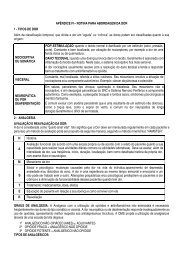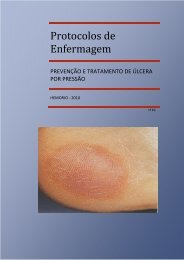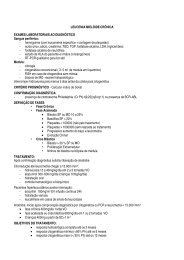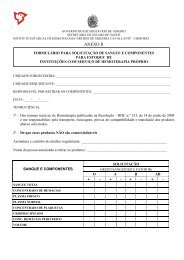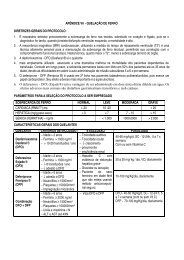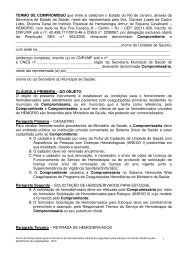Protocols - Hemorio
Protocols - Hemorio
Protocols - Hemorio
You also want an ePaper? Increase the reach of your titles
YUMPU automatically turns print PDFs into web optimized ePapers that Google loves.
CLINICAL AND LABORATORIAL FOLLOW-UP ROUTINE<br />
- TO DIAGNOSIS: beta-glycosidase dosage, chitotriosidase (biomarkers) dosage, DNA study, skeleton<br />
x-rays (lumbar, spine, chest, sacro-iliac, hip panorama, femoral and femurs), total abdomen ultrasound,<br />
complete blood count and biochemistry* (*urea, creatinine, TGO, TGP, alkaline phosphatase,<br />
GGT,BTF, PTF, glucose, ferritin, calcium), clotting and serology studies. It is recommended to perform<br />
bone densitometry and MRI of lumbar spine, hips and femur in adults.<br />
- First 2 years of treatment: monthly medical evaluation, complete blood count and biochemistry* every<br />
3 months, total abdomen ultra-sound every 6 months, annual bone evaluation and serology. Annual<br />
repetition of chitotriosidase dosage.<br />
- After 2 years of treatment: quarterly medical evaluation, complete blood count and biochemistry*<br />
every 3/6 months, total abdomen ultra-sound every 6m/1year, annual bone evaluation and serology.<br />
Repetition of chitotriosidase dosage every two years. Evaluate repetition of MRI and densitometry of<br />
lumbar spine, hip and femurs every 2 years for adults.<br />
- Patients without treatment indication: medical evaluation, complete blood count and biochemistry*,<br />
every 3/6 months, total abdomen ultra-sound every 6 months, annual bone inventory. It is<br />
recommended to perform bone densitometry and, if possible, MRI of lumbar spine, hips and femurs.<br />
- Other tests in specific situations: electrophoresis of proteins and immunoglobulin dosage, B12<br />
vitamin dosage, bidimensional echocardiography with Doppler, anti-imiglucerase antibody dosage<br />
before starting enzyme replacement, specific IGE dosage for imiglucerase in cases of reactions to the<br />
drug, x-rays of other sites having pain crisis.<br />
- Patients with GD type III: brain MRI, evoked potential, electroencephalography, follow-up with a<br />
neurologist.<br />
ENZYMATIC REPLACEMENT TREATMENT (ERT)<br />
ADMINISTRATION: The enzyme is reconstituted in sterile water for injection, diluted in 100-200 ml of<br />
saline solution 0.9% and endovenous infusion in 1-2 hours, every 14/14 days (or 15/15 days). Doses are<br />
calculated individually, by U/Kg of patient’s weight. Administration during pregnancy must be evaluated<br />
according to risk x benefit.<br />
INITIAL DOSE AND MAINTENANCE:<br />
Patients Initial Dose When does the dose should be<br />
changed?<br />
GD type I<br />
Adults and children<br />
without severe disease<br />
GD type I<br />
Adults and children with<br />
severe disease<br />
GD type III<br />
30 U/kg<br />
60 U/Kg<br />
60 – 120U/kg<br />
(bimonthly)<br />
After normalization of criteria<br />
which lead to the beginning of the<br />
treatment<br />
84<br />
After 24 months, if there is any<br />
normalization of beginning of<br />
treatment criteria<br />
Maintenance Dose<br />
Children: 30U/Kg<br />
Stable Adults: 20 up to 15U/Kg<br />
30 U/Kg<br />
For treatment failure we suggest weekly infusion



